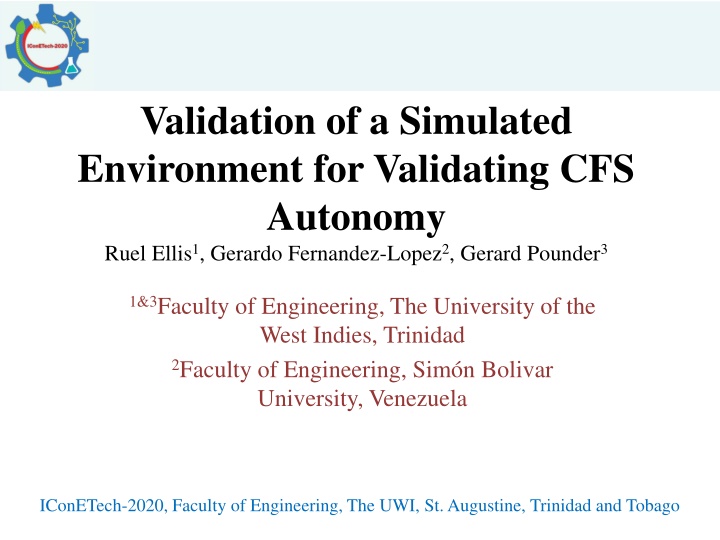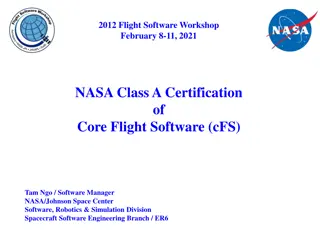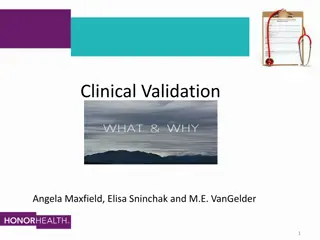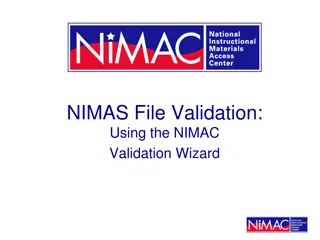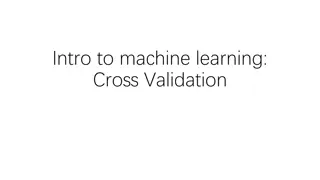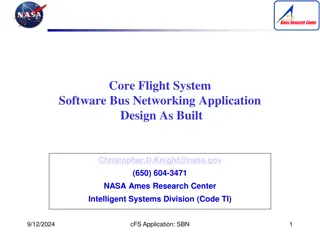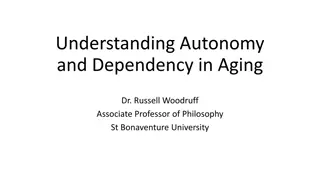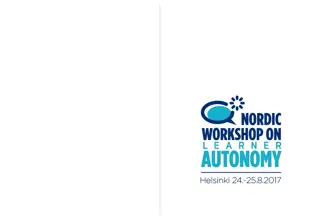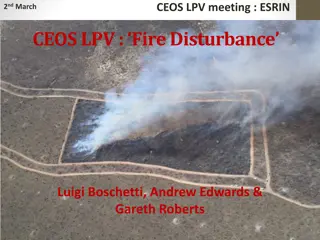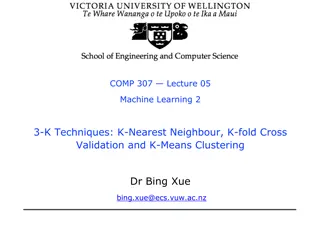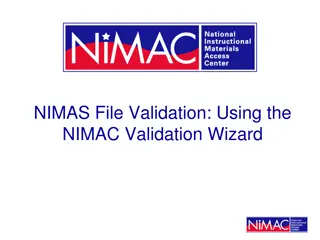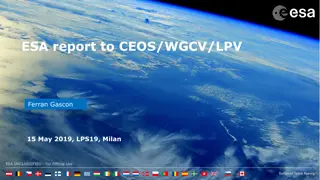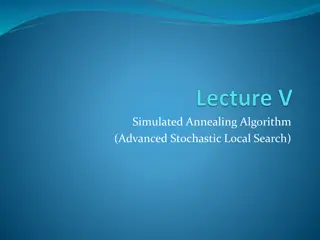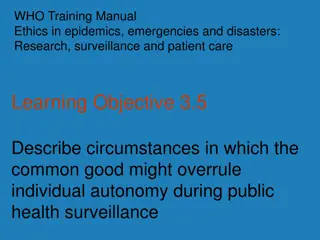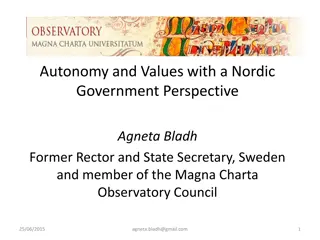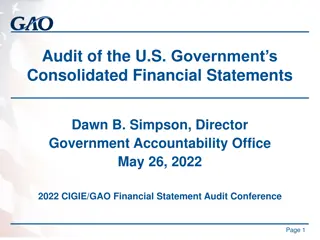Validation of Simulated Environment for CFS Autonomy
A presentation on the validation of a simulated environment developed for analyzing Cognitive Function Synthesis (CFS) navigation autonomy. The study identifies variables, designs experiments, and presents findings related to system performance with or without an Obstacle Avoidance Algorithm in CFS navigation. The research integrates literature reviews on Artificial General Intelligence (AGI) and introduces the CFS conceptual framework for AGI. The simulated environment is thoroughly examined and validated to enhance understanding of CFS navigation capabilities.
Download Presentation

Please find below an Image/Link to download the presentation.
The content on the website is provided AS IS for your information and personal use only. It may not be sold, licensed, or shared on other websites without obtaining consent from the author.If you encounter any issues during the download, it is possible that the publisher has removed the file from their server.
You are allowed to download the files provided on this website for personal or commercial use, subject to the condition that they are used lawfully. All files are the property of their respective owners.
The content on the website is provided AS IS for your information and personal use only. It may not be sold, licensed, or shared on other websites without obtaining consent from the author.
E N D
Presentation Transcript
Validation of a Simulated Environment for Validating CFS Autonomy Ruel Ellis1, Gerardo Fernandez-Lopez2, Gerard Pounder3 1&3Faculty of Engineering, The University of the West Indies, Trinidad 2Faculty of Engineering, Sim n Bolivar University, Venezuela IConETech-2020, Faculty of Engineering, The UWI, St. Augustine, Trinidad and Tobago
CONTENTS Introduction Objectives Methodology Literature Review Design of Experiments: System & Dependent Variables Results References IConETech-2020, Faculty of Engineering, The UWI, St. Augustine, Trinidad and Tobago
INTRODUCTION A previous presentation described the environment developed for CFS Navigation Validation. Ultrasound Sensor Configuration Figure 1. State Diagram for robot, screenshot of environment and US configuration This presentation showcases the findings obtained from the simulated environment developed for analysing CFS navigation autonomy. IConETech-2020, Faculty of Engineering, The UWI, St. Augustine, Trinidad and Tobago
OBJECTIVES To identify dependent and independent variables for the simulated environment. To design experiments to determine whether the difference in system performance with/without an Obstacle Avoidance Algorithm is statistically significant. To present findings. IConETech-2020, Faculty of Engineering, The UWI, St. Augustine, Trinidad and Tobago
METHODOLOGY Identify the dependent and independent variables. Design experiments to determine whether the difference in system performance with/without an Obstacle Avoidance Algorithm is statistically significant. Compare performance and present findings. IConETech-2020, Faculty of Engineering, The UWI, St. Augustine, Trinidad and Tobago
LITERATURE REVIEW Artificial General Intelligence, or AGI, recommends a functional structure of cognitive modules in which interdependent relationships between components are identified a priori (Bach 2008). Cognitive theories may incorporate cognitive functionality as independently subsisting cognitive modules where the cognitive modules are treated as add-ons (Arkin 1998, Opie 1998, Franklin 2007) Other theories may incorporate Agents (Wei and Hindriks 2013). Bruckner et al. (2012) observed an openness to new conceptual frameworks for cognitive approaches to AI amongst researchers. Pounder, Ellis and Fernandez-Lopez (2017) introduced the Cognitive Function Synthesis (CFS) conceptual framework to AGI. Fernandez-Lopez, Ellis and Pounder (IConETech 2020) described the simulated environment developed to investigate CFS navigation. This paper presents results to validate this simulated environment. IConETech-2020, Faculty of Engineering, The UWI, St. Augustine, Trinidad and Tobago
DESIGN OF EXPERIMENTS: SYSTEM & DEPENDENT VARIABLES Table 1. System Variables and Dependent Variables For Obstacle Avoidance 7 7 7 7 n = number of experiments required S = Sample standard deviation x = mean A = required accuracy IConETech-2020, Faculty of Engineering, The UWI, St. Augustine, Trinidad and Tobago
THE DEPENDENT VARIABLES (1) (2) IConETech-2020, Faculty of Engineering, The UWI, St. Augustine, Trinidad and Tobago
THE DEPENDENT VARIABLES (3) Figure 5. Previously illustrated initial results of robot performance with and without obstacle avoidance IConETech-2020, Faculty of Engineering, The UWI, St. Augustine, Trinidad and Tobago
RESULTS Table 2. Robot Performance Results With Only Basic Reflexes IConETech-2020, Faculty of Engineering, The UWI, St. Augustine, Trinidad and Tobago
RESULTS Table 3. Robot Performance Results With Braitenberg Obstacle Avoidance IConETech-2020, Faculty of Engineering, The UWI, St. Augustine, Trinidad and Tobago
RESULTS IConETech-2020, Faculty of Engineering, The UWI, St. Augustine, Trinidad and Tobago
RESULTS Table 4. Independent Samples Hypothesis Test for a Difference Between Sample Means between 8-sensor and 16-sensor configuration Student t value = 3.055 Student t value = 3.055 IConETech-2020, Faculty of Engineering, The UWI, St. Augustine, Trinidad and Tobago
RESULTS Table 5. Independent Samples Hypothesis Test for a Difference Between Sample Means between Braitenberg and No Obstacle Avoidance Student t value = 3.055 Student t value = 3.055 IConETech-2020, Faculty of Engineering, The UWI, St. Augustine, Trinidad and Tobago
CONCLUSION Contact/Collision simulation results show : difference in performance of the 16 sensor over the 8 sensor US configuration, was significant for all Variables: Braitenberg Obstacle Avoidance simulation results show: difference in performance of the 16 sensor over the 8 sensor US configuration, was significant for: Avg Cycle Time & Avg Shock Treatment Comparing performance between the Braitenberg Obstacle Avoidance and Contact/Collision reflexes, where sensor configuration is held constant, the difference in performance is significant due to the obstacle avoidance algorithm. These findings can only be predicated of this sample. Revisiting the data to remove outliers may enable findings to be generalized to the population without the need for excess simulation runs. IConETech-2020, Faculty of Engineering, The UWI, St. Augustine, Trinidad and Tobago
REFERENCES Bach, J. 2008. "Seven principles of synthetic intelligence." In Proceedings of the First AGI Conference on Artificial General Intelligence, 2008, edited by P. Wang, B. Goertzel and S. Franklin, 63-74. Amsterdam, Holland: IOS Press. Franklin, S. 2007. "A foundational architecture for artificial general intelligence." In Proceeding of the AGI Workshop 2006 on Advances in Artificial General Intelligence: Concepts, Architectures and Algorithms, 2007, edited by P. Wang and B. Goertzel, 36-54. Amsterdam, Holland: IOS Press. Ragni, M., and F. Stolzenburg. 2015. "Higher-level cognition and computation: a survey." KI - K nstliche Intelligenz 29(3):247-253. Arkin, R. C. 1998. Behavior-Based Robotics. Cambridge, Massachusetts: MIT Press. Opie, Jonathan. 1998. "Consciousness: a connectionist perspective." PhD Diss., University of Adelaide. Wei, C. and K. V Hindriks. 2013. "An agent-based cognitive robot architecture." In Proceedings of the International Workshop on Programming Multi-Agent Systems, 2012, edited by M. Dastani, J.F. Hubner and B. Logan, 54-71. Berlin: Springer-Heidelberg. Bruckner, D., H. Zeilinger, and D. Dietrich. 2012. "Cognitive automation - survey of novel artificial general intelligence methods for the automation of human technical environments." IEEE Transactions on Industrial Informatics 8(2):206-215. Lepora, N. F., P. Verschure, and T. J Prescott. 2013. "The state of the art in biomimetics." Bioinspiration and Biomimetics 8(1):1-11. De Garis, Hugo, Chen Shuo, Ben Goertzel, and Lian Ruiting. 2010. "A world survey of artificial brain projects, part I: large-scale brain simulations." Neurocomputing 74(1):3-29. Goertzel, B., R. Lian, I. Arel, H. de Garis, and S. Chen. 2010. "A world survey of artificial brain projects, part II: biologically inspired cognitive architectures." Neurocomputing 74(1):30-49. Hawkins, Jeffrey, Subutai Ahmad, Dileep George, Frank Astier, and Ronald Marianetti. 2013. Architecture of a hierarchical temporal memory based system. edited by United States Patent and Trademark Office. U.S.: Google Patents. Edelman, G. M., J. L. Krichmar, and D. A. Nitz. 2008. Mobile brain-based device having a simulated nervous system based on the hippocampus. edited by United States Patent and Trademark Office. U.S.: Neurosciences Research Foundation, Inc. Thibeault, C. M. 2012. Applications in Neurorobotics MSc Diss., University of Nevada, Reno. Pounder, G. A. J., R. L. A. Ellis, and G. Fernandez-Lopez. 2017. "Cognitive Function Synthesis: Preliminary Results." Kybernetes 46(2):272-290. Fernandez-Lopez, G., R. L. A. Ellis, and G. Pounder. 2020. "Description of a Simulated Environment Developed for Validating CFS Autonomy." ICONETECH, UWI, St Augustine, Trinidad. Vernon, D., G. Metta, and G. Sandini. 2007. "A Survey Of Artificial Cognitive Systems: Implications For The Autonomous Development Of Mental Capabilities In Computational Agents." IEEE Transactions On Evolutionary Computation 11(2):151-180. Krichmar, J. L, and J. A. Snook. 2002. "A neural approach to adaptive behavior and multi-sensor action selection in a mobile device." In Proceedings 2002 IEEE International Conference on Robotics and Automation, 3864-3869 IEEE Press. Brooks, R. A. 1986. "A robust layered control system for a mobile robot." IEEE Journal of Robotics and Automation 2(1):14-23. IConETech-2020, Faculty of Engineering, The UWI, St. Augustine, Trinidad and Tobago
THANK YOU! QUESTIONS ??? IConETech-2020, Faculty of Engineering, The UWI, St. Augustine, Trinidad and Tobago
